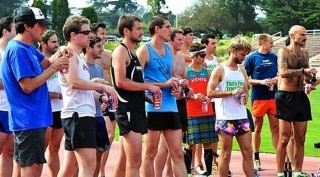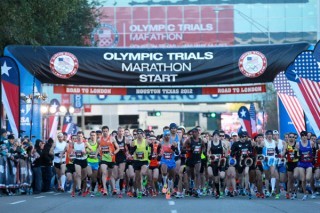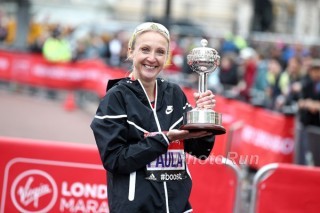Ryan Hall's Blog, page 364
August 20, 2015
Swiss Athlete Runs ‘5 Peaks in One Day’ Challenge in Remarkable Time

Andreas Steindl, a Swiss alpinist and adidas Outdoor athlete, recently did a remarkable bit of running. He ran more than 19 miles (30.66 kilometers) from Zermatt to Saas Fee in Switzerland—by crossing five peaks that exceed 4,000 meters (13,120 feet).
Even more remarkable is the time he pulled it off in. To run 19 miles, with nearly 13,500 feet of elevation gain over pathless terrain, glaciers and exposed ridges, Steindl needed just 7:45:44.
Here’s a video from Epic TV documenting the impressive feat:
The post Swiss Athlete Runs ‘5 Peaks in One Day’ Challenge in Remarkable Time appeared first on Competitor.com.
Tips For Running A Beer Mile

Photo: Courtesy of Beer Mile World Classic
Running a beer mile is no easy task. Sure, it sounds simple: pound a 12-ounce beer, run a lap on a track and repeat three more times as quickly as possible without puking. But having the fitness to run a fast-ish mile is only part of the gig. Here are some insights from three elite runners competing in the inaugural Beer Mile World Classic on Aug. 22 on Treasure Island in San Francisco Bay.
Buying
Choosing the right beer is the first step in running a successful beer mile. To follow official regulations (aka, “The Kingston Rules”), your beer must have at least a 5 percent alcohol content. However, not all beers are created equal. Mass-produced lighter beers with higher water content like Keystone Ice, Natural Light and Busch Light are often the beer of choice for top beer milers, although James Nielsen’s 4:57.1 world record was set while drinking Budweiser. “It’s important to choose a beer that’s close to 5 percent and smooth in terms of carbonation,” says Michael Cunningham, a sub-4:00 miler from Brewster, N.Y., who owns a 5:07.95 beer-mile PR. “Personal taste preference also comes into play, as the beer should be pretty tolerable in order to keep down the 48 ounces consumed in only a few minutes.”
Imbibing
Learning how to drink beers quickly is an important skill. It’s important to remain calm and drink gradually, so as not to gag while swallowing or getting a mouth full of foam. And yes, training helps. “I’ll practice holding my breath for 1 minute, then immediately drink a beer as quickly as possible,” says Canadian Jim Finlayson, who owns a 5:09 beer-mile PR. Fellow Canadian Lewis Kent (a 5:01 beer-miler) practices by quickly draining four beers in training and, more regularly, pounding 12 ounces of water from beer bottles. “You have to make sure your stomach is ready for that much liquid on race day,” Lewis says. Many top beer-milers say having the beer at room temperature—or at least removed from the refrigerator 30-60 minutes prior to running—makes it easier to digest.
RELATED: Canadian Lewis Kent Lowers Beer Mile WR to 4:55.8
Burping
There isn’t any real science to drinking four beers during a mile race, but you should heed the physics. It’s not the alcohol that creates challenges—well, at least not until about 5 minutes after you finish—it’s the sloshing of liquid and the carbonation in your stomach that’s the main problem. “Use smooth handling techniques while opening and chugging to prevent the beer from fizzing as much as possible, and be conservative early in the race—especially with the first beer—in terms of drinking speed and running pace,” Cunningham says. “Definitely slow down to avoid vomiting so you don’t get DQ’ed!” Also, try to get rid of as much carbonation in your stomach as possible after the completion of each beer. In other words, don’t be shy about letting out a big burp or many!
The post Tips For Running A Beer Mile appeared first on Competitor.com.
U.S. Olympic Trials Marathon Will Be Televised Live on NBC

Photo: PhotoRun.net
The U.S. Olympic Trials marathon in February will be televised live nationally on NBC, it was announced today. It’s the first time that the marathon will be broadcast live.
The broadcast will start at 1 p.m. EST (10 a.m. local time) on Feb. 13, 2016 from downtown Los Angeles. In addition to the telecast on NBC, the marathon will be live streamed on NBC Sports Live Extra—NBC Sports Group’s live streaming platform for desktop, mobile, tablet and TVs.
“Being able to ensure live, national television coverage was a top priority for USATF in the 2016 Olympic Trials selection process,” said USATF CEO Max Siegel. “With NBC’s coverage, the stars of one of this country’s biggest cultural and athletic movements will receive unprecedented national exposure. February 13 will be a great day for distance running in the United States.”
RELATED: Sizing Up 2016: Who Will Make the U.S. Olympic Marathon Team?
The 2012 U.S. Olympic Trials marathon in Houston—the first time the men and women raced on the same course—was also televised, but it was tape-delayed and aired later in the day.
The marathon in February will start and finish in downtown Los Angeles. The course was designed to be spectator-friendly, featuring one 2-mile loop through downtown and four 6-mile loops that will travel into South Los Angeles, going through the University of Southern California campus and passing by Exposition Park and the LA Coliseum—home of the 1984 Olympics.
The top three finishers in the men’s and women’s races will earn the right to compete for the U.S. in the 2016 Olympics marathon next August in Rio de Janeiro.
RELATED: 2016 Olympic Trials Marathon Course Revealed
The post U.S. Olympic Trials Marathon Will Be Televised Live on NBC appeared first on Competitor.com.
How to Maintain Training and Balance When Life Gets in the Way

Photo: Shutterstock.com
Excerpted from “Run Like a Champion: An Olympian’s Approach For Every Runner” by Alan Culpepper. Copyright © 2015 by Alan Culpepper. Published by VeloPress and reprinted by permission. All rights reserved.
Several years ago I had a business meeting with the then mayor of Tempe, Ariz., Hugh Hallman. At the time we met, he was training to run a marathon and was leading a charity organization that had raised a lot of money through a race. He had only been running for five years but had come to fully embrace the essence of running and the freedom, clarity of thought, and daily satisfaction of accomplishment it brought to his life.
As we concluded our meeting, he told me he was going to meet his wife for an evening run together. I was amazed that he still had plans to run after what had surely been an exhausting day, but it was a good example of how he found balance in his life. He shared that he absolutely had to run, not only for his sanity but also because it was his time to connect with his wife and talk about their days. After they ran, he would go home and eat, shower and work a few more hours before going to bed.
RELATED: Rise and Run: How to Become a Morning Runner
What’s the point of that story? As long as you schedule for it and make it a priority, running can fit into any schedule. Sure, plenty of things will get in the way—the biggest variables for most runners, regardless of ability or experience level, are weather, illness, travel, and family or work commitments—the key is knowing how to manage those situations. Sometimes compromise is in order. The key question you have to ask yourself is whether the workout or run will set you back more than it will be of benefit.
The post How to Maintain Training and Balance When Life Gets in the Way appeared first on Competitor.com.
August 19, 2015
Training Plan: 10 Weeks to a Faster 10K

Photo: Shutterstock.com
If you’ve finished a few 10Ks and want to race your next one faster, this intermediate to advanced training plan, created by Mario Fraioli, Competitor senior editor, Olympic coach and author of The Official Rock ‘n’ Roll Training Guide, is aimed at helping you get stronger and faster over a 10-week period.
Now’s the perfect time to start fine-tuning your fitness for cross-country season, the annual Thanksgiving Turkey Trot or another favorite fall event.
FREE 10K Training Plan
Click here for the printable PDF: 10 Weeks to a Faster 10K
RELATED ARTICLES:
— Workout of the Week: Mile Repeats
— Coach Culpepper: Find Your Tempo
— Brad Hudson’s 3-2-1-2-3 Fartlek Workout
The post Training Plan: 10 Weeks to a Faster 10K appeared first on Competitor.com.
Trail of the Week: Leadville Trail 100 Course

Photo: Glen Delman Photography
Our Trail of the Week feature is made possible through a partnership with Trail Run Project.
One of the most famous ultramarathons in the U.S. takes place Sunday in Colorado, as runners will take off from the old mining town of Leadville for the Leadville Trail 100.
So what exactly are these runners in for?
The course is an out and back from downtown Leadville. The primary obstacle is the formidable 12,600-foot Hope Pass, near the apogee of the course. That section is simultaneously the most beautiful and most painful part of the race. Hope will threaten to drain just that from you as you dig deep to get up and over. And since it’s an out and back course, you’ve got to do it twice.
The notorious Powerline section is the first and last significant climb of the course. This brutal section accounts for more than 4,000 feet of vertical change and is characterized by loose, rutted, consistently steep doubletrack following, well… a power line.
The final crusher is the long stretch of road back into Leadville. By then, you’re 100 miles in and on your way to a coveted buckle—and bragging rights for life.
The Data
Miles: 99.7
Runnable: 90 percent
Singletrack: 35 percent
Average Grade: 5 percent
Max Grade: 40 percent
Total Ascent: 13,904 feet
Total Descent: -13,903 feet
Highest Elevation: 12,506 feet
For a closer look, check out the interactive map, data, photos and virtual run simulator courtesy of Trail Run Project:
The post Trail of the Week: Leadville Trail 100 Course appeared first on Competitor.com.
Is Running Good For Weight Loss?

Photo:Shutterstock.com
When people are asked why they run, an overwhelming majority cite the desire to lose weight (and presumably get healthier in other ways as well). But is running really the best way to shed pounds?
“The simple answer is ‘yes, it is a good exercise,’” says Glenn Gaesser, a professor of exercise science at Arizona State University. “Running is as good as anything and probably better than a lot of others.”
On a very simple level, it’s just a matter of calories burned versus calories consumed. And at approximately 100 calories per mile, depending on your size and the terrain, running provides a fairly good bang for your buck: Run faster, cover more miles, burn more calories.
Of course, it can get a lot more complicated than that. Theoretically, losing one pound is roughly equivalent to a 3,500-calorie deficit. Theoretically, that makes the equation very straightforward—but if you’ve found that not to be the case, you’re not the only one.
“You run 35 miles, you should lose a pound,” says Gaesser, “but it never works out that way.”
RELATED: How Many Calories Does Running Burn?
The reason it doesn’t work out is multifold. People tend to overestimate their effort and eat more calories than they actually burned. (That’s not only true if they actually work out, but is also true if they just see people working out. One study, said Paul Williams, a PhD at the Berkeley National Laboratory who has focused on runners and walkers, found that people who watched promotional exercise videos consumed more calories after seeing the vigorous activity on screen, despite not having done anything themselves.)
The other problem is that your body automatically compensates for how much you exercise. Even in a metabolic chamber, which is a closed chamber used as a scientific research tool to measure calories and energy expenditure, there are still compensatory changes in a person’s metabolism after exercise, says Gaesser. What that means is that even when there should be no outside influences, studies have still found that a person’s resting metabolic rate goes down when they’re on an exercise program. Basically, your body finds a way to conserve energy.
Other studies—using motion sensors—have also found that after exercise, especially harder exercise, it’s common for people to become less active throughout the rest of the day. (Imagine yourself lounging on the couch all day after a tough long run.) And there are suspected hormonal changes that happen as well, affecting how you burn fuel, says Gaesser.
That’s partially why, after a certain amount of time running long, slow miles, many people experience a plateau. At that point, a good idea might be to try something else, such as interval training. (Or, get younger. Simply maintaining your mileage as you age—instead of increasing volume or intensity—can still result in weight gain because of metabolic changes that come with years. “If that’s not depressing, I don’t know what is,” says Gaesser.)
“Variety is the spice of life,” says Edward Lakowski, the co-director of Mayo Clinic Sports Medicine.
While running isn’t a bad way to lose weight, just running might not burn off as many pounds as you’re hoping. Weight training can also have a benefit, he says, since muscle does burn additional calories—though people tend to overestimate the amount they truly worked in the gym.
RELATED: Carbohydrate Cycling for Weight Loss
A number of studies have shown that running burns more calories than walking for the same mileage—the break point between walking and running, in case you were wondering, is about four to five miles per hour. In that same vein, high-intensity exercise—be it running fast intervals or something more along the lines of a bootcamp-style circuit—has been shown to have a number of health benefits. There are also some studies that suggest the higher the intensity, the more fat you burn, particularly because very high intensity exercise can have an after-burn effect—burning another 10-15 percent of the calories you did in the workout for a few hours after you’ve finished.
But, warns Gaesser, that only comes from doing at least an hour at 75-80 percent of your VO2 max—the maximum amount of oxygen you can use—which is harder than most people are willing to go.
Plus, if you go too hard or do too much too soon, you might find yourself hurt or burned out—and sitting on the couch won’t burn many calories at all. To that end, cycling or swimming or rowing might be more productive if you’re arthritic or have biomechanical issues when it comes to running. This can make figuring out exactly how to burn the most calories a little tricky.
For example: In an average hour of running at a moderate pace (7-1/2 miles), I burn about 750 calories. An hour of cycling at the same effort (or heart rate) would burn about 450 calories for me. That makes it seem clear cut; running is the way to go. But there’s slightly more to the math. I am only capable of running about five to six hours per week before I start to get avoidable aches and injuries. If scheduling weren’t an issue, I could easily bike 10 to 15 hours each week before having a similar body breakdown. That means the actual equation is some kind of calculation maximizing calories burned as a product of running and cycling, with respect to time and injury potential.
In terms of burning calories, you need to use a lot of big muscle groups—except for one big outlier: swimming. Because of temperature differences in the water and body regulation, swimming tends to be the worst for weight loss, says Gaesser. You lose a lot of heat, which tends to result in more calorie consumption than you actually burned.
“For most people, time is the limiting factor,” says Williams, which is why running is more efficient than walking longer, cycling or swimming. Plus, you don’t need a pool to run or any expensive equipment. It’s also inexpensive, you can do it anywhere and there are also more running races and running clubs than other sports, making it more fun for many people.
“The best exercise is one that people like to do,” says Laskowski. Generally, only one-third of people actually comply with medication instructions and prescriptive exercises, so the more people actually do what they know they should, the better. “The easier it is, the more you’re going to do it.”
The post Is Running Good For Weight Loss? appeared first on Competitor.com.
Paula Radcliffe Wary On Publicly Releasing Blood Data

Paula Radcliffe ran her last competitive marathon at the London Marathon in April. Photo: PhotoRun.net
In contrast to the recent actions of a few of her country’s most notable track & field stars, marathon world record holder Paula Radliffe of Great Britain told BBC sports editor Dan Roan that athletes shouldn’t reveal their blood data, as Jo Pavey, Lisa Dobriskey and Mo Farah and others did earlier this month.
The 41-year-old Radcliffe, who ran the final marathon of her competitive career in London this past April, said the blood data is complicated and can be misunderstood and misinterpreted by non-experts.
“The key point is you can’t prove you are clean,” Radcliffe explained to BBC Sport. “We don’t have a foolproof, 100 percent testing program in place right now so we can’t prove that. In some sense, what Wada are trying to say is we don’t want this data out there in the public domain because people don’t understand it, it is very complicated. … I think if you put too much of that information in the public domain you risk doing a lot of things, you risk it being misunderstood and misinterpreted, you also risk putting information into the hands of people who are trying to cheat that system and who then are going to learn the information of how to manipulate and how to make sure they stay within this perfect zone and that is not what we want or what it was ever designed to do.”
RELATED: Radcliffe Wants Suspicious Blood Values Revealed
Radcliffe, who set the still-standing marathon of 2:15:25 at the 2003 London Marathon, has been one of track & field’s strongest anti-doping voices, despite suspicions and accusations that her seemingly untouchable marathon marks were aided by performance-enhancing drugs. She has never failed a drug test.
“The whole point is you go through your career, you look back and say, ‘That was the best I could do,'” Radcliffe told the BBC. “If you take a short cut, you can’t say that. You can’t look yourself in the mirror and say that was the absolute best you were capable of.”
RELATED: Radcliffe’s Last Marathon One To Remember
The post Paula Radcliffe Wary On Publicly Releasing Blood Data appeared first on Competitor.com.
Paula Radcliffe Weary On Publicly Releasing Blood Data

Paula Radcliffe ran her last competitive marathon at the London Marathon in April. Photo: PhotoRun.net
In contrast to the recent actions of a few of her country’s most notable track & field stars, marathon world record holder Paula Radliffe of Great Britain told BBC sports editor Dan Roan that athletes shouldn’t reveal their blood data, as Jo Pavey, Lisa Dobriskey and Mo Farah and others did earlier this month.
The 41-year-old Radcliffe, who ran the final marathon of her competitive career in London this past April, said the blood data is complicated and can be misunderstood and misinterpreted by non-experts.
“The key point is you can’t prove you are clean,” Radcliffe explained to BBC Sport. “We don’t have a foolproof, 100 percent testing program in place right now so we can’t prove that. In some sense, what Wada are trying to say is we don’t want this data out there in the public domain because people don’t understand it, it is very complicated. … I think if you put too much of that information in the public domain you risk doing a lot of things, you risk it being misunderstood and misinterpreted, you also risk putting information into the hands of people who are trying to cheat that system and who then are going to learn the information of how to manipulate and how to make sure they stay within this perfect zone and that is not what we want or what it was ever designed to do.”
RELATED: Radcliffe Wants Suspicious Blood Values Revealed
Radcliffe, who set the still-standing marathon of 2:15:25 at the 2003 London Marathon, has been one of track & field’s strongest anti-doping voices, despite suspicions and accusations that her seemingly untouchable marathon marks were aided by performance-enhancing drugs. She has never failed a drug test.
“The whole point is you go through your career, you look back and say, ‘That was the best I could do,'” Radcliffe told the BBC. “If you take a short cut, you can’t say that. You can’t look yourself in the mirror and say that was the absolute best you were capable of.”
RELATED: Radcliffe’s Last Marathon One To Remember
The post Paula Radcliffe Weary On Publicly Releasing Blood Data appeared first on Competitor.com.
Morganne Hockett: 5 Quick Tips to Improve Running Form

Photo: Shutterstock.com
When I first got into running, I simply picked up my feet, swung my arms and went. Proper running wasn’t something I considered until I started training for my first half marathon. My dad watched me run on a treadmill and said “great running form” and that’s when it hit me: what is proper running form?
A quick Internet search for “proper running form” left me lost, confused, and second guessing my ability to run. There was a puzzle of scientific jargon: swing phase, stance time, loading rate, stretch reflex and perfect running posture.
But the more I practiced various techniques, the more I realized the importance of doing it right. Focusing on improving running form will help cut your risk of overuse injuries so you can run more consistently. Through years of practice and experience I’ve determined what works for me and other runners I coach.
Rather than getting lost in the scientific technicalities, stick to these five simple tips.
Push off. Focus on pushing up and off the ground behind you. One of my favorite tips is to look at photographs of elite runners, and you can see the power behind each stride.
Short, quick strides. Avoid reaching forward with your foot, which can lead to over-striding, causing too much impact shock through the leg, and leading to injury.
Stand up straight. Maintain a tall, straight back without slouching. There should be a slight lean forward that happens from your ankles, not your waist, but this happens naturally without effort.
Keep your knees in line. Make sure your foot strikes under your knee, not in front of it, which can lead to injury. It actually does not matter what part of your foot hits the ground first, forefoot, midfoot, or heel, just be sure that your foot is not in front of your knee.
Arm Swing. Keep your elbows bent at 90 degrees or less. When you swing your arms with your stride, pretend you are pulling something out of your pocket to keep your shoulders relaxed and not tensed. Make sure your hands are loose and do not cross your midline in order to maintain proper gait.
When it comes to tackling a hill, you’ll need to adjust your form accordingly. Here are a few tips to keep in mind when climbing or descending a hill.
CLIMBING UPHILL
Keep your head and chest up and shoulders back.
Push up and off the hill, springing from your toes.
Don’t hunch over and bend at the waist.
DESCENDING DOWNHILL
Visualize “controlled falling.”
Keep your fists loose and shoulders relaxed.
Step softly; don’t let your feet pound the ground.
Remember, running does not have to be scientific or complicated. Simply focus on these fundamentals and you’ll notice immediate improvements in your runs!
The post Morganne Hockett: 5 Quick Tips to Improve Running Form appeared first on Competitor.com.
Ryan Hall's Blog
- Ryan Hall's profile
- 21 followers



